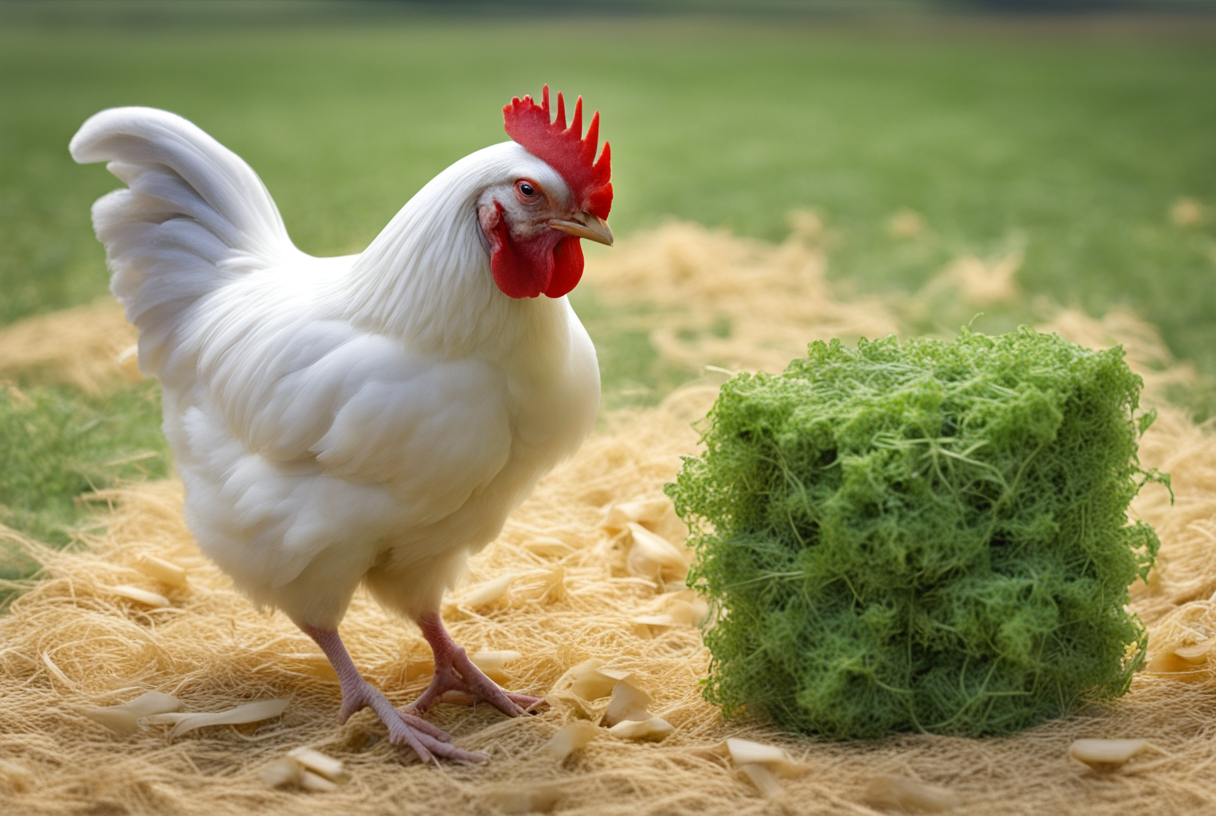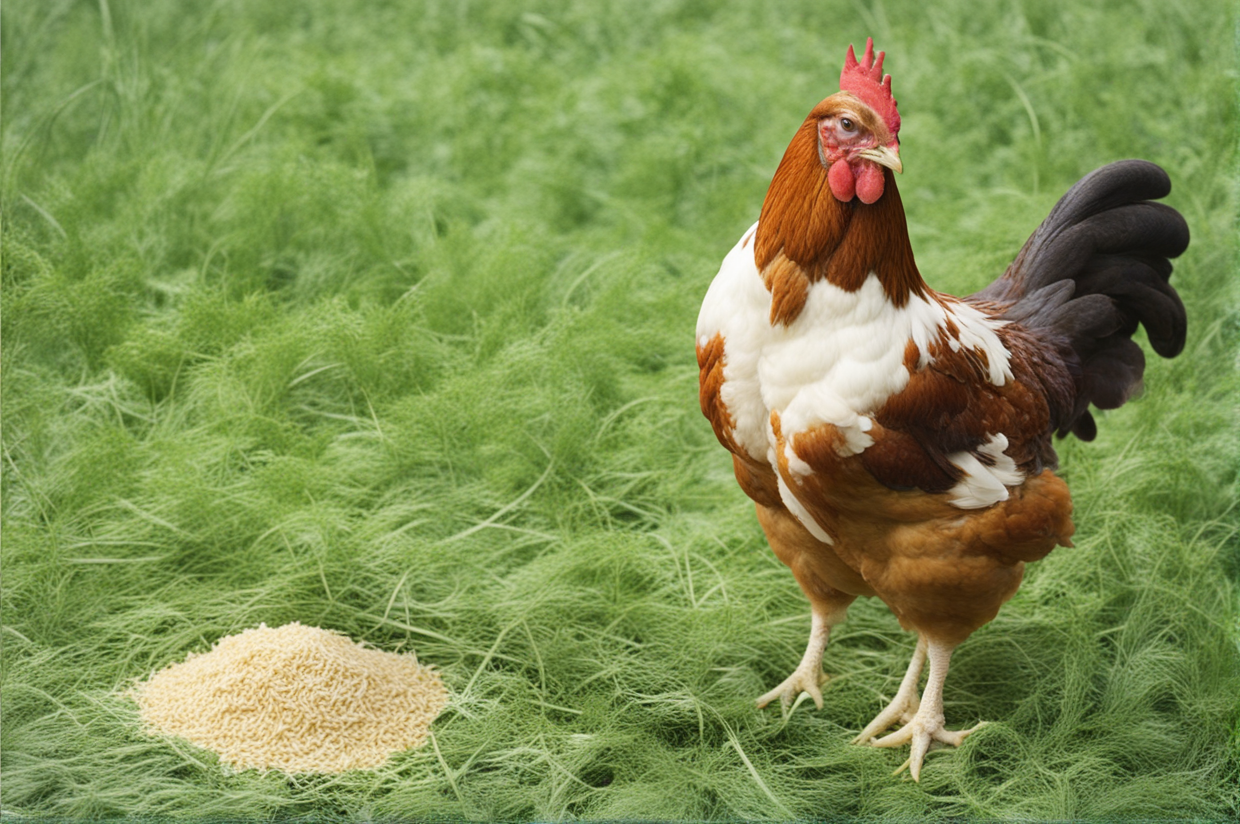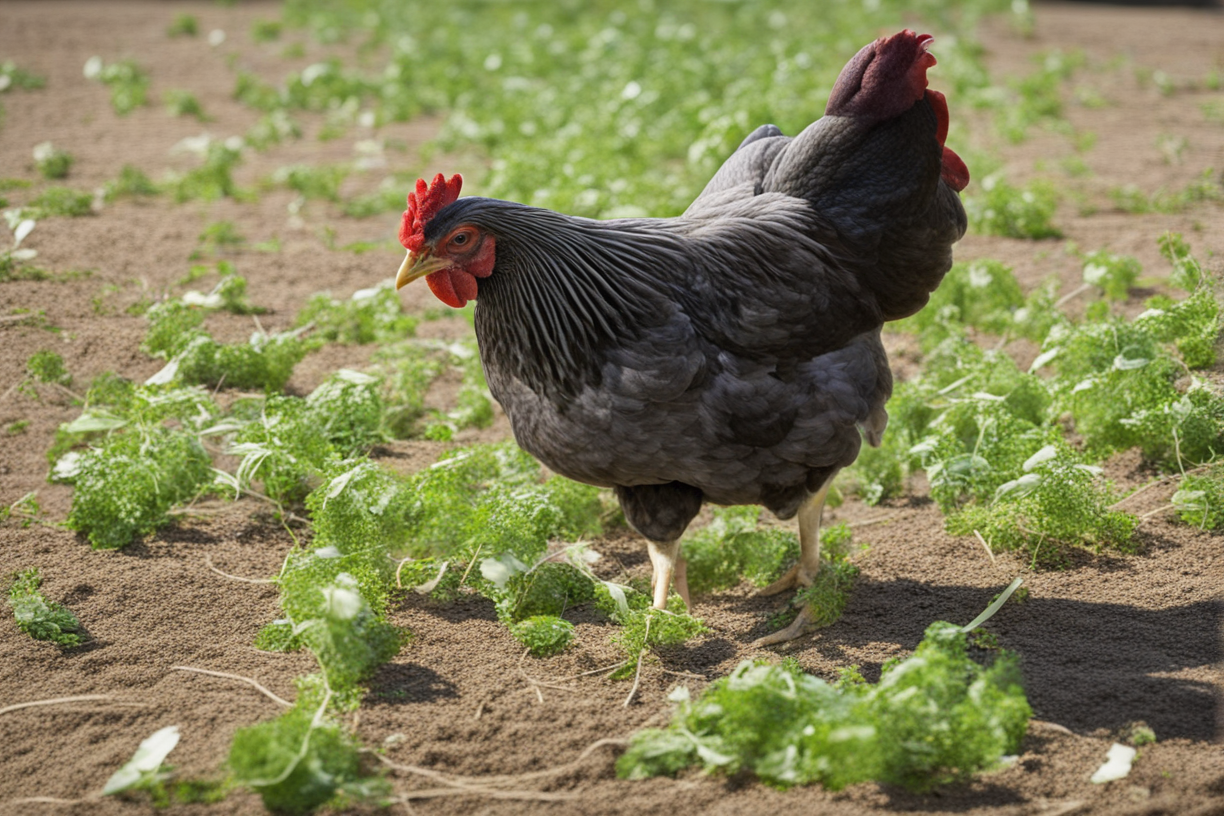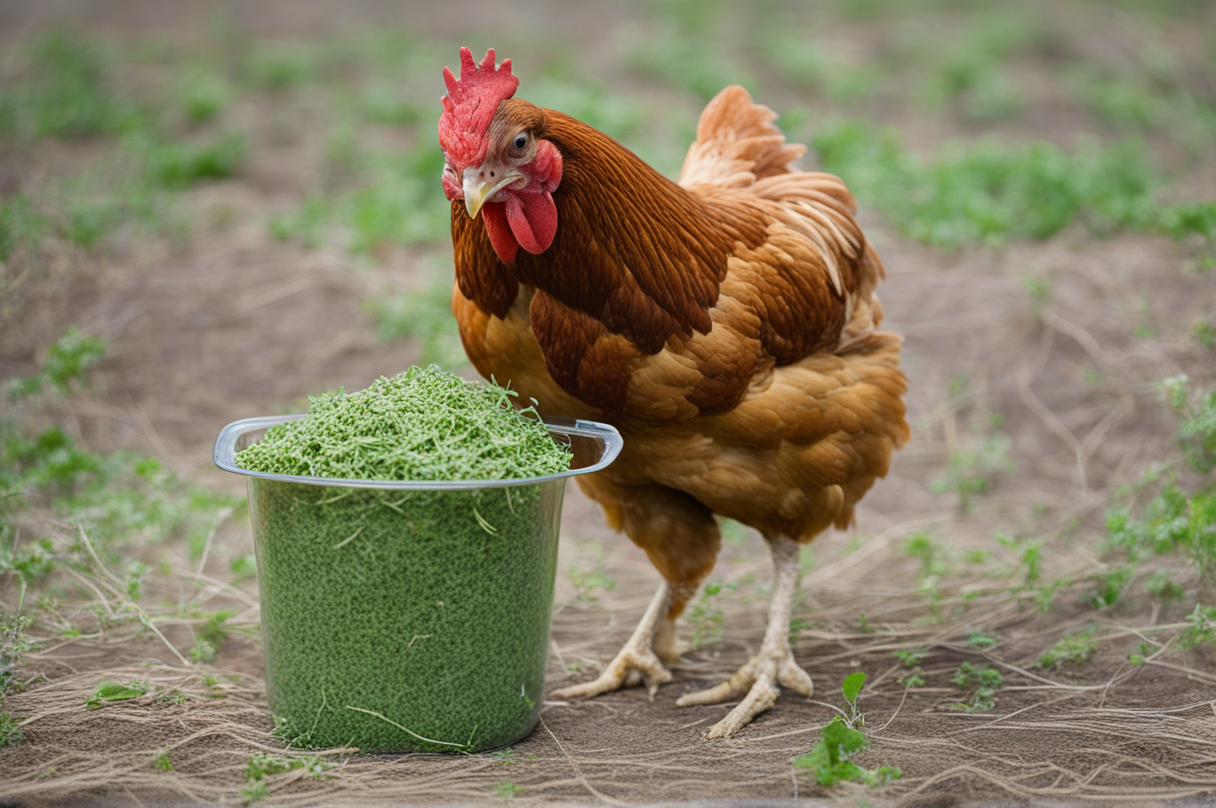Let me tell you about the time I tried making my own alfalfa meal for my chickens.
I just got my first little flock of 6 Rhode Island Red laying hens last spring and being the overeager new chicken dad I am, I wanted to make sure they were eating only the best feed.
So I got it in my head that I’d grow and dry my own alfalfa to grind into nutritious meal for my girls.
I did a bunch of research online and learned that alfalfa is full of protein, vitamins, and minerals that are great for chicken health and egg production.
I ordered alfalfa seeds and planted up a quarter acre plot this spring with visions of waving green alfalfa fields that would provide me with more than enough alfalfa hay for my small flock.
Then summer rolled around and my crop was pitiful – we had a record heat wave of 100 degree temps for 2 weeks straight and a bad drought.
I ended up with a tiny patch of scraggly, stunted alfalfa that was only ankle high and full of weeds.
It yielded about 10 pounds of hay – hardly enough for a single day’s worth of meals for my 6 chickens, let alone weeks’ worth that I’d hoped for.
That’s when I realized I was in way over my head trying to grow and dry my own alfalfa crop.
Here’s what I learned about the easy way to make quality alfalfa meal for backyard chickens.
Table of Contents
Buy Your Alfalfa

Don’t try to grow your own alfalfa like I did, it’s really not worth the hassle and challenges of planting, growing, harvesting, drying and storing a good alfalfa crop yourself when you just have a small backyard flock.
Especially if you’re new to gardening and agriculture like me.
Instead, just buy pre-dried alfalfa hay, pellets or chop from a feed store or online retailer.
That way you know it’s been grown and dried properly for optimal nutrition.
There are tons of farmers growing quality alfalfa hay on a large scale who can do it much better than any small time backyard operation.
You can find 40-50 pound bags of dried alfalfa hay, pellets or chop at your local farm/feed store, online retailers like Amazon or Chewy, or even at some pet stores in the rabbit or guinea pig section.
Make sure to buy from a reputable source and check the ingredients to ensure it’s 100% pure alfalfa without fillers, grains or artificial ingredients.
Alfalfa pellets may be more convenient for grinding compared to loose alfalfa hay.
Grind It Up

To turn the dried alfalfa into meal, you need to grind it into a fine powder.
Get yourself a heavy duty grain mill, food processor, high power blender like a Vitamix, or a dedicated alfalfa milling machine.
You’ll need something with some real power that can grind up the tough, fibrous stems of the alfalfa into a super fine powder.
I first tried using my cheap $20 blender from Target and burned up the little motor after just 30 seconds of grinding.
So I invested $350 in a heavy duty Vitamix blender made for grinding grains and it has worked amazingly ever since.
Grind small batches of no more than a cup or two at a time.
Anything more can jam up your machine and prevent the alfalfa from pulverizing properly.
Grind in short 5-10 second pulses until the alfalfa is a fluffy, super fine powder.
Make sure there are no remaining chunks, stems or coarse pieces – it should look like dust.
I like to sift the ground meal through a mesh strainer to make sure it’s perfectly pulverized.
A fine powder will mix into your chickens’ feed better and be easier for the chickens to digest than coarsely ground chunks.
Store Properly

Freshly ground alfalfa meal goes rancid quickly because of its high fat content from all the vitamins.
So proper storage is critical.
Keep your alfalfa meal in an airtight container in the fridge or freezer.
Only grind up as much meal as you’ll use within a week or two.
If it smells bitter, musty, or makes your nose wrinkle, it has already gone bad from oxidizing and rotting.
Toss it and grind a fresh batch.
I label my containers with the date I ground it so I know how old it is.
Freezing in smaller portions helps prevent waste since it keeps longer frozen.
There you have it folks – with good quality alfalfa and the right grinding and storing methods, making your own alfalfa meal is quick and easy.
No green thumb or farming equipment required!
Just remember to buy dried alfalfa from a reputable source, invest in a heavy duty grinder, and use airtight storage to prevent it from spoiling quickly.
Now if you’ll excuse me, I’ve got 6 hungry Rhode Island Red ladies clucking for their fancy homemade treats.
Let the professional farmers grow quality alfalfa then just buy pre-dried hay, pellets or chop from your local feed store or online retailer like Amazon.
Invest in a powerful heavy duty grinder like a Vitamix made for pulverizing tough, fibrous alfalfa into a super fine powder.
Choose Your Alfalfa Type
There are a few different options when it comes to the type of alfalfa to buy for grinding into meal.
Alfalfa hay is the dried leaves and stems of the alfalfa plant cut into bales.
It’s the most natural form but can have more stems and be more time consuming to grind up.
Alfalfa pellets are made by taking alfalfa hay and compressing it into small pellet shapes that are uniform in size.
The pellets allow for easier handling when grinding and mixing into chicken feed.
Alfalfa chop is chopped up alfalfa hay into smaller pieces but not pelletized.
Alfalfa cubes are another chopped and compacted form that is intermediate between pellets and loose chop.
Any form will work fine, so choose based on your personal preference and what’s most convenient to purchase and grind in your system.
Pellets or cubes may be easier for a home grinding setup.
Amount to Feed Your Flock
When mixing your alfalfa meal into your chickens’ feed, how much alfalfa should you add?
A good rule of thumb is to mix the alfalfa meal 50/50 with your regular grain feed.
So if you feed 1 pound of grain mix per day, add 1 pound of alfalfa meal to it.
This gives your flock a healthy balance of energy, protein, vitamins and minerals.
For younger chicks under 6 months old, mix 25% alfalfa meal and 75% grain feed.
They need a higher proportion of grains for growth.
You can gradually increase the alfalfa ratio as they mature.
Laying hens can go up to 75% alfalfa and 25% grains to support egg production.
Adjust the ratios based on your specific flock’s needs and monitor their health and egg production.
Dietary Benefits of Alfalfa
Why go to the trouble of grinding alfalfa meal to feed your backyard chickens?
What benefits does alfalfa provide over plain grains or layer feed?
There are many great reasons to supplement your flock’s diet with alfalfa meal:
Alfalfa is very high in protein, vitamins A, E, K and B vitamins which promote growth and egg production.
It also provides minerals like calcium, phosphorus, iron and potassium for strong bones, nerves and muscles.
The nutrients in alfalfa support chicken immunity, disease resistance, and feather, comb and wattle health.
Alfalfa increases productive energy compared to grains so hens lay more eggs.
Its fiber aids digestion to reduce incidence of impacted crop.
The carotenoids act as antioxidants for overall health and longevity.
So grinding your own alfalfa meal lets you provide all these benefits!
Considerations for Meat Birds
While alfalfa meal is great for laying hens, meat chickens like broilers have different nutritional needs.
Broilers are bred for rapid growth and weight gain in order to reach slaughter size as quickly as possible.
Therefore, they need a higher protein, higher energy feed concentrate to support maximum growth rates.
Too much alfalfa can actually inhibit weight gain in meat birds.
For broilers, stick to a feed formulated specifically for meat birds with at least 18-22% protein.
You can include 10-15% alfalfa meal in their diet, but don’t go over 20% or their growth could slow down.
Free-ranging on fresh pasture grasses will provide health benefits without hurting growth.
Heritage breed chickens raised for meat can handle a bit more alfalfa but still monitor weight gain.
Drying Your Own Alfalfa
If you really want to grow your own alfalfa, here are some tips for drying it yourself:
Cut the alfalfa when it is at the pre-bloom stage, around 2 feet tall, for optimal nutrition.
Use a scythe, sickle bar mower or weed whip to cut it.
Allow the cut alfalfa to wilt in the field for a day to remove moisture.
Gather into small bundles and hang to dry out of direct sun if possible.
The drying process takes 4-7 days depending on humidity.
Test for dryness by bending a stem – it should snap easily.
Thorough drying is crucial to prevent mold or spoilage.
Store the completely dried alfalfa in a dry spot out of sunlight until ready to grind.
Home drying requires the right climate conditions and extra time, so buying pre-dried is often easier.

